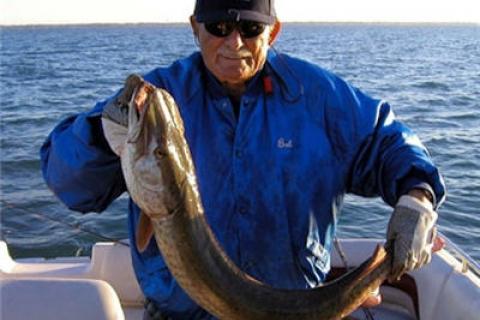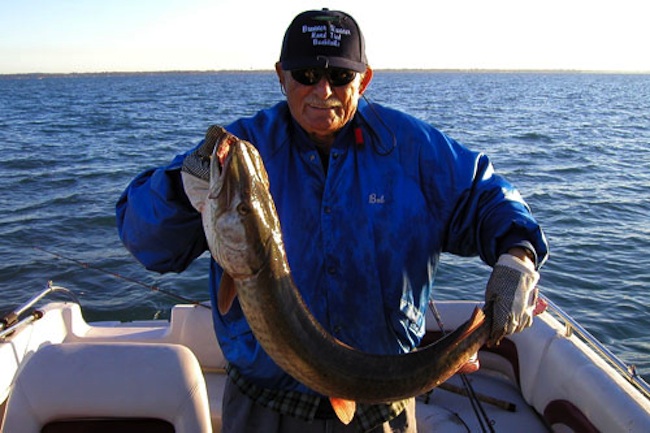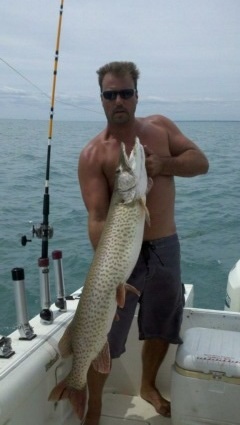
A few months ago, I was visiting the Bass Pro Shop in Auburn Hills. The store managers, Tom and Greg, and I were talking about one of my passions, muskie fishing. During the conversation, Muskie Bob's name came up several times. I was surprised to learn they were acquaintances of Bob.
Who is Muskie Bob? That's a complex answer. The first time I met Bob Brunner, my father had set up a muskie trip with an old pro and invited me to tag along. I had no idea who Bob Brunner was. All I knew was that he offered my father knowledge that he acquired over the last 65 years casting for muskie in Anchor Bay. As an avid muskie fisherman, I had to go.

We met Bob at a little restaurant not far from the boat launch. When Bob walked in, I noticed he was an older gentleman and walked with a cane. Small talk over breakfast and throughout the day led to many stories worth hearing.
GROWING UP
Bob was born in 1924. Interestingly, that same year, the world record muskie (at that time) was caught. He told me the fish was caught on a Red Eye Spoon, the same type spoon he was casting as he was telling me the story.
He grew up near the shores of Lake St. Clair. His first muskie was caught on a cane pole back in 1931. Motors weren't an option then and Bob and his father rowed a 16-foot leaky rowboat throughout Anchor Bay in search of the bounties the waters had to offer.
Over the years, Bob was so intrigued with the muskellunge, he became one with the waters he loved. He learned how currents created by wind and the St. Clair river could affect Anchor Bay. These mighty forces helped carve the underwater topographical features of one of the nation's largest inland lakes, and Bob knew them well! THE WAR HERO
THE WAR HERO
On his cane, I saw the inscription Utah Beach 1944. I asked Bob if he would tell me about his overseas tour. He was hesitant, but gave me some information more people should know. After graduating high school in 1944, Bob enlisted in the Army because he felt his country needed him.
Following basic training, Bob was assigned to the 4th U.S. Cavalry. This elite unit was to be the first American military unit to hit the shores of Europe to liberate the French countryside. German forces were dug in the hedgerow country and the 4th Cavalry was the very first recon unit, with the 1st Army following.
One of Bob's never forgotten memories was that German tanks and artillery would launch a shell toward their position every 10 minutes, 24 hours a day, trying to break the Americans and keep them sleep deprived. Bob told me that he and his unit did not sleep for days on end because of the constant bombardment.
Only weeks into the raging war, Bob and his unit were caught in a run and gun with two German tiger tanks. Bob knew his unit was in trouble and he single handedly took out one of the tanks with an RPG, saving countless lives.
As the second tank's turret turned towards Bob, he looked up to the sky and asked to go home Instantly, an 88 millimeter shell landed only three feet from Bob. Bob's short tour in one of the biggest overseas battles in history lasted a short while; the next 15 months were spent in a hospital fighting for his life.
THE LURE MANUFACTURER
After recovering from his injuries, Bob, like every other vet, went to work, raised a family, and resumed his fishing career. In 1980, he dedicated his time, through research on the water, and created a line of lures that suited his needs. They were lures that a fisherman could cast all day, with little effort, through weed-choked waters, where trolling was impossible, in search of fish of mythical proportions.
The Brunner Runner was born! A muskie-sized, weighted, buck tail spinner with a built-in wire leader. Bob field tests his creations on the fish themselves. He learned by changing blade sizes, shapes, and weights, that he could fish his favorite areas with ease.
The fish couldn’t resist his offerings. The large blade sizes create vibration and lift enabling you to buzz the buck tails just under the surface and over the expansive weed beds, which is hard to do with other types of lures. These baits create so much havoc underwater that they seem to call the big fish in. I've seen them in action.
In addition to the leaderless lure and blade selection, Muskie Bob hand ties beautiful buck tails in various colors to enhance his Brunner Runners. Over the years, Bob has come up with the right combinations of colors to catch fish in any situation.
For the past several years, my father and I have been fortunate to help Bob field test some of his creations. One that really drew fish to the boat was a gold blade, gold beaded, black buck tail with a streak of red. Bob named it the Black Rose after my grandmother, Rose Lee, a lure worthy of the name.
THE AUTHOR
In addition to Bob's fishing and lure-making skills, he is an accomplished author as well. He took decades of learned knowledge and put them into words.
In 1984, Bob wrote Casting Anchor Bay . The book explodes with Bob's knowledge. Another book, Casting: The Feast or Famine of Fishing, was published in 1985. The following year, Bob produced yet another book, Lake St. Clair's Big Three. All books are worthy of reading if you want to learn more about the Great Lakes, Lake St. Clair in particular, or muskies. These and more current publications are listed on his website.
FISHING HALL OF FAMER
Bob's 65 years of pursuing muskie on Lake St. Clair, as well as other waters, has led him to the pinnacle of his career. In 2005, Muskie Bob Brunner was inducted into the Freshwater Fishing Hall Of Fame in the Detroit Bass Pro Shops, becoming one of the elite on muskie waters.
Bob has caught hundreds of trophy fish. The largest muskie was 56.5 " and weighed 52 pounds. It was caught in Brevoort Lake in the Michigan's UP on a Red Eye spoon.
At 85 years of age, Bob will cast all day and spends his summer months guiding fishermen in their own boats in pursuit of the illusive water wolves.
HUMAN GPS
To cast efficiently for muskie you need a stable boat designed to fight the elements and big water conditions that Lake St. Clair can throw at you. A GPS is a must, a priceless piece of equipment. I would not leave the launch without one.
In Bob's day, these luxuries were not an option. All he had was a simple row boat, a good set of oars, an anchor, and a lot of physical effort. Can you imagine rowing miles of water, fighting the wind and elements, solo, in a small wooden boat on Anchor Bay?
Through trial and error, Bob learned to read the shore lines for features to triangulate his position in order to find his favorite muskie haunts. We're talking about 38,000 acres of water! Many times, I've found myself questioning my own GPS due to the mass expanse of water.
A small miscalculation can put you off course and waste valuable time, not good when you are looking for a weed bed that only stretches a few hundred yards.
On a recent trip, I watched Bob as we were nearing a good stretch of water. I was driving the boat and had the GPS zoomed in to one-half mile. Bob was sitting to my left and couldn't see the screen, but tapped me on my shoulder and told me to veer to the left 300 yards and tell him when were over the 8- to 7-foot break.
I was watching the GPS and didn't say anything. As we reached the depth, Bob told me to head 400 yards due south and shut the boat down. We were 100 yards directly upwind of the waypoint I had stored . . . unbelievable!
LESSONS LEARNED
On another trip, we launched the boat in water that laid flat like glass. As we were making our way through the channel, I was punching in a waypoint for the weed bed where we pulled some good fish up the week before.
Out of the blue, Bob said, “We're going for a boat ride?” I didn't argue. I followed Bob's directions, proceeded to put over 12 miles on the boat, passing a lot of Bob's hot spots, areas that looked like giants could be hanging out waiting for our lures.
After the trip, we ended up in the same weed bed I was heading for an hour prior. I could tell he was waiting for me to say something about the boat ride. I looked at Bob and thanked him for the insight.
The rest of the trip, Bob showed my father and I several depth contours where he has caught fish for decades, explaining how the weed edges change from year to year due to the change in the bottom carved by wind and currents.
The seeds from vegetation always seem to find the simple changes in depth where the currents drop them, generating life throughout the food chain in isolated stretches of the abyss.
Wind direction is the key to the muskie hunter. Bob taught us how to use landmarks along with depths to find weed edges in murky water or when the sun refuses to show them.
By using his visual aids on the horizons along with the wind, we could drift across the rich waters without missing, a feat hard to do on such a large expanse of water. This was a lesson well learned.
CONCLUSION
Casting for muskie is for the dedicated sportsman. Very few fishermen know the hardship serious addicts endure. Having a friend like Muskie Bob ups my odds every time we hit the water. I highly recommend Bob's specially tuned Brunner Runners. For information on the lure and Bob, visit his website at www.michiganmuskiebob.com.
Written by David Lee
- 4733 views

